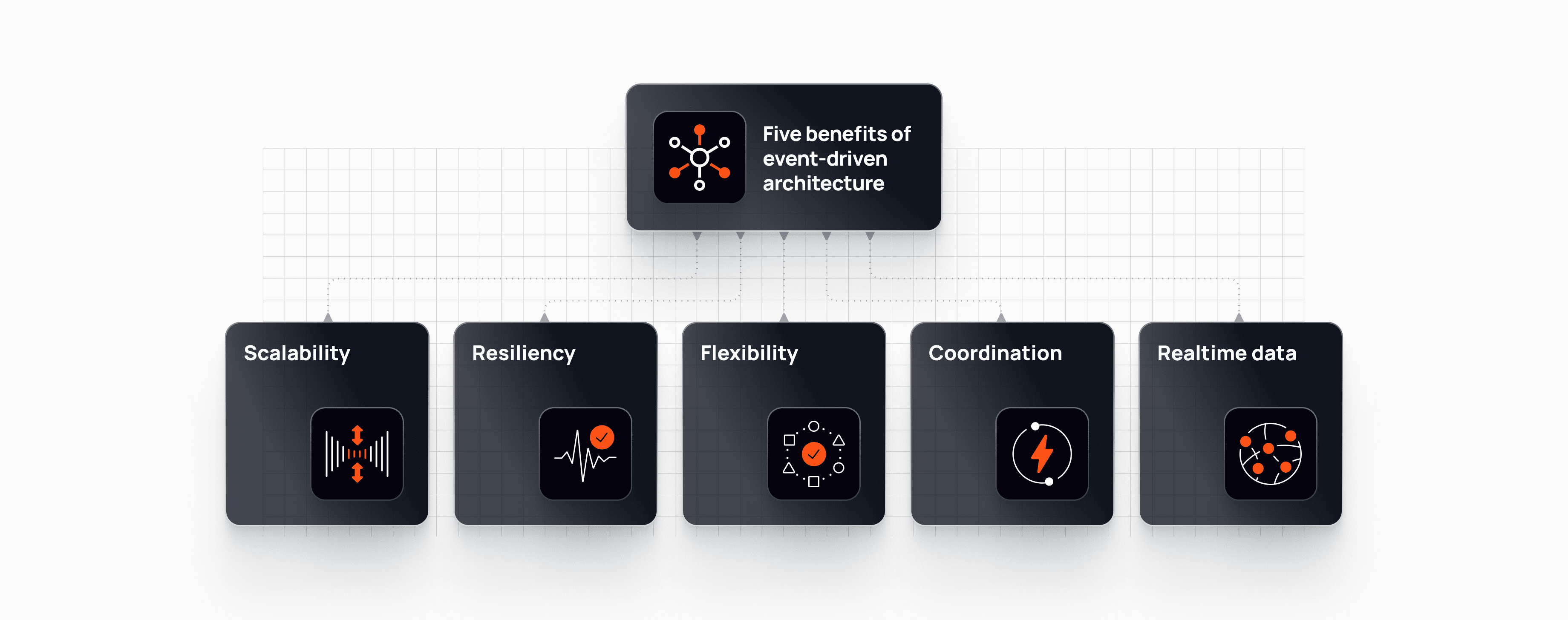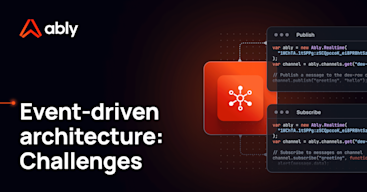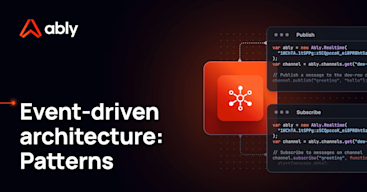- Topics
- /
- /
- 5 key benefits of Event-Driven Architecture (and how it can help you scale)
5 key benefits of Event-Driven Architecture (and how it can help you scale)
Traditionally, software architecture has a request/response design. Application components post a request to another component and wait for a response before proceeding. With the rise of realtime data and the ever-growing need for enterprise scalability, companies are increasingly replacing request/response with a new architecture design: Event-driven architecture.
Event-driven architecture, or EDA, is a model of application design that prioritizes the flow of events instead of having components post requests and wait. In EDA systems, the components that publish events and the components that deliver events are decoupled – joined only by a broker that mediates event routing.
Companies can benefit from this asynchronous messaging in a range of ways, including making more scalable applications and enabling better-coordinated microservices. Here, we’ll explore these benefits in detail and show how certain use cases make some companies particularly suited to EDA.
5 benefits of event-driven architecture
EDA systems offer a variety of benefits – most of which come from the asynchronous communication enabled by decoupling publishers and subscribers.
That said, EDA isn’t a good fit for all companies and all use cases (see more on EDA challenges here). Generally, the benefits EDA offers are most worthwhile for enterprises with large codebases and companies with complex lines of business applications.

1. Scalability
One of the greatest reasons companies consider adopting EDA is how well it supports scalability – especially in moments of extreme user and traffic fluctuation.
EDA’s increased scalability is enabled by the loose coupling between publishers and subscribers. If there’s a moment of increased data load or traffic, a loosely coupled EDA system is easier to scale. Development teams don’t have to worry about downstream components and can instead add resources only to the components that need them.
EDA systems pair this greater scalability with greater efficiency. In an EDA system, components can receive events and updates without needing to request them. Since these components don’t need to post requests, companies can reduce network I/O even as they get instant updates and even as they scale.
2. Resiliency
EDA systems shine in contexts where significant scalability is necessary and resiliency becomes difficult. Consider customer service chat features, for example, which need to scale realtime services to customers across the world while remaining resilient.
Here, the loose coupling inherent to EDA systems provides support. Because components in an EDA system are loosely coupled, one component doesn’t need to worry about the status of another component. If one component or microservice goes down, the rest of the application can keep running. If the subscriber fails, for example, event channels can store events that the subscriber can retrieve when it comes back.
In contrast, because request/response systems are synchronous, the failure of one component often means another component is stuck retrying its requests until the failed component recovers.
One of the strongest EDA use cases, for example, is enabling companies to transmit near-instant messages across a range of IoT devices. If a device goes down, which is often likely when they’re placed at a network’s edge, the device can keep publishing events and the subscriber can keep functioning until it reconnects.
This level of resilience also improves fault tolerance. When a component goes down, the events it produces are stored in an event queue and no matter how long it takes for the component to recover, the queue ensures no data loss and enables event processing once the subscriber is back.
3. Flexibility
EDA systems tend to be much more flexible than request/response systems, which is especially useful for services and applications that have a special need to be efficient – either for the sake of scalability, realtime features, or both.
EDA systems offer topic routing and filtering processes that can divide different kinds of events and messages. If development teams need to add another component, they can have the new component subscribe to the publisher and receive events without disrupting an already existing message flow. They can even have that subscriber produce its own events without the addition affecting existing functionalities.
This level of decoupling-enabled flexibility is especially useful for microservices-based applications. Similar to microservices more broadly, with EDA, teams can add more subscribers as necessary without affecting already established publishers. That means teams can implement separate microservices that use different languages or technologies. Publishers don’t need to know anything about subscribers; instead, subscribers only need to connect to the event stream.
EDA also adds flexibility via efficiency through the reduction of temporal coupling. As we’ve covered, request/response systems are synchronous, which means they have temporal coupling. In a request/response system, all the components involved in a particular chain of requests and responses need to be available for the process to function. But in EDA, each component operates independently and no component is blocked by another.
This flexibility is especially useful for use cases like payment processing. If a customer makes an order and the billing component fails to reach the warehousing inventory component, a request/response system could charge the customer without fulfilling the order.
In an EDA system, each service is independent, so if the warehouse component fails or is otherwise unavailable, nothing else fails. The process will just continue once the warehouse component recovers.
4. Coordination
In a benefit that sometimes seems counterintuitive at first glance, EDA – by introducing a middleware broker – can actually improve the coordination between components.
In a distributed system, a broker ensures publishers and subscribers can work independently by handling the routing of messages to subscribers within its own self-contained logic. The publishers and subscribers work in close conjunction but neither are actually connected to the other.
This tight-knit collaboration – despite loose coupling – helps development teams too. With separate development teams working on separate components, teams can operate independently and both can work faster.
If one component is connected to another via API, for example, a request/response system would require the team handling one component to make an API call to the other component when the other team makes a change. That process then requires authentication, communication overhead, and over time, a slowdown in development speed.
But with EDA, the broker handles message routing and no other component-to-component communication is necessary. Development teams can operate independently as long as they can connect to the broker, which handles the rest.
5. Realtime data
IDC research shows that by 2025, almost 30% of data will be realtime. Realtime data refers to data that is produced and routed at a speed that feels instantaneous to end users – even when updates are distributed at a global scale.
The use cases for realtime data are vast, ranging from enabling sports applications to send realtime score updates to enabling logistics companies to offer realtime shipment monitoring dashboards. EDA is particularly useful in realtime data contexts because the shift from request/response to event-driven systems – particularly the resulting reduction in message delays – is necessary for an effective realtime infrastructure.
One of the reasons realtime data is rising in popularity, for example, is machine learning. With EDA, machine learning models can subscribe to events and broadcast the results of their analysis to other components in realtime. EDA also helps with iterating these models because event streams can record events as they happen, allowing development teams to analyze, iterate, and audit.
When EDA becomes a competitive advantage
EDA, as we’ve covered, isn’t appropriate for all companies but in the right context, it can support an array of powerful differentiators.
Enterprises with intensive scalability needs can meet demand more dependably and more reliably with EDA.
Businesses with microservices systems can use EDA to connect and coordinate their systems more effectively.
Companies offering realtime updates features can support them best with an EDA system available to facilitate the passage of realtime data.
The tradeoffs of EDA, however, aren’t worthwhile in all contexts.
Smaller businesses and companies with relatively simple features often find EDA systems to be excessively complex.
Despite the name, EDA is a poor fit for media streaming, so companies looking to stream content will benefit from more specialized designs.
Read our guide for more on EDA including a deep dive in to the major EDA patterns, use cases, and benefits, and challenges.
Recommended Articles

Event-driven architecture: Everything you need to know in 2024
Event-driven architecture, or EDA, is a software architecture that decouples event publishers and subscribers to enable realtime message delivery.

Event-driven architecture: Challenges and how to overcome them
Event-driven architecture (EDA) is a complex solution to a complex problem. Here, we cover a few of EDAs biggest challenges and how to manage with them.

Event-driven architecture patterns and when to use them
Discover the two major patterns for event-driven architectures and the use cases for each, complete with examples.